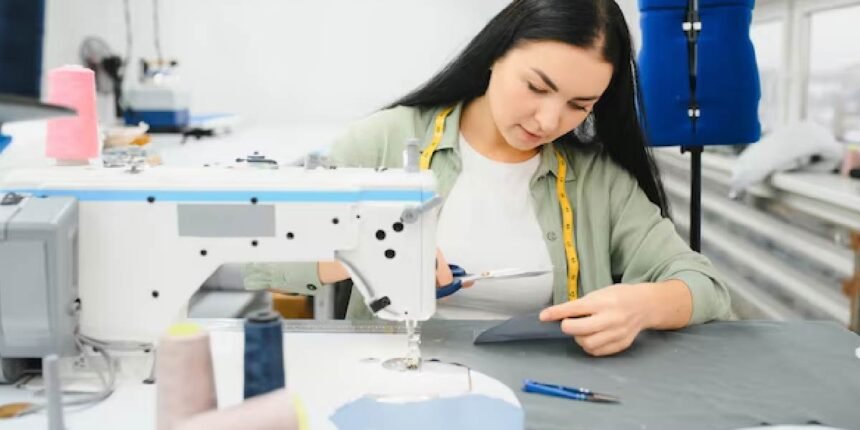Introduction to Nahttypen
When you dive into the world of sewing, one of the most critical yet often overlooked elements is the type of seam used in construction. Known in German as “Nahttypen,” seam types are the foundation of how fabrics are joined, shaped, and finished. Whether you are crafting a tailored dress, a piece of technical outdoor gear, or a simple home decor project, the seam you choose determines not only how your piece looks but also how long it will last and how it will function. Nahttypen play a major role in determining durability, comfort, elasticity, and style.
This comprehensive guide covers all aspects of Nahttypen—from basic and advanced seam types to fabric compatibility, hand vs. machine stitching, seam finishing methods, innovations in modern seam technology, and common mistakes to avoid. Whether you’re a beginner or a seasoned professional, this informative article will help you fully understand what Nahttypen are and how to use them effectively in your sewing journey.
What Are Nahttypen?
Nahttypen, translated directly from German, means “types of seams.” In sewing, a seam is the line where two pieces of fabric are stitched together to create a finished product. The term Nahttypen refers to the wide variety of seams available, each with different construction methods, strengths, aesthetics, and functions. While stitches are the individual loops or passes made by a needle and thread, Nahttypen refers to the structural form created when fabric is joined, layered, and reinforced.
Seams are more than just joints—they influence the final shape of garments, provide reinforcement at high-stress points, and define the aesthetic of both the exterior and interior of a product. For example, a clean French seam can make a silk blouse look seamless inside and out, while a flat-felled seam in denim reinforces strength in high-wear areas. Understanding different Nahttypen enables sewists to make informed decisions based on fabric type, garment usage, desired appearance, and production method.
Importance of Choosing the Right Seam Type
Choosing the right seam type, or Nahttyp, is essential for achieving a professional-looking and durable sewing project. The strength of your final product heavily depends on how well the seam type suits the fabric and use case. Some seams are flexible and stretch-friendly, ideal for activewear and knit garments, while others are rigid and reinforced, best for denim, canvas, or outerwear. For example, using a basic straight stitch seam on stretchy jersey fabric can lead to popping and breakage, whereas an overlocked seam allows the fabric to stretch while maintaining seam integrity. The seam type also impacts garment aesthetics and fit.
A decorative topstitched seam on a jacket not only adds strength but serves as a visual element. Seam placement and type are particularly crucial in fashion, sportswear, upholstery, and technical garments, where performance and appearance must coexist. Selecting the wrong Nahttyp can lead to puckering, seam failure, discomfort, or visual imbalance, making seam choice one of the most important design decisions in sewing.
Historical Evolution of Nahttypen
The concept of Nahttypen has evolved significantly throughout history, influenced by technology, fabric innovation, and changing fashion trends. In early human civilization, primitive needles made of bone or wood were used to sew animal hides with sinew, creating rudimentary seams to provide warmth and mobility. As fabric production and tailoring advanced, so did seam complexity. In medieval Europe, garments began incorporating inset sleeves and curved seams, requiring specialized stitch types.
The industrial revolution brought sewing machines, allowing for consistent, faster stitching and new seam constructions like the overlock. In the 20th century, high-performance garments—military uniforms, workwear, and outdoor gear—prompted the development of reinforced seam types like double-stitched and flat-felled seams.
Today, Nahttypen has expanded into cutting-edge techniques like bonded seams and ultrasonic welding, used in waterproof or technical fabrics. Seam types have also become central to design aesthetics, from the minimalism of flat seams in modern sportswear to the elaborate topstitching of haute couture. This evolution highlights how Nahttypen reflects both cultural history and functional innovation.
Overview of Common Seam Types (Basic Nahttypen)
Understanding the most common Nahttypen is essential for both beginners and professionals. The plain seam (einfache Naht) is the most frequently used and serves as the foundation for many sewing projects. It’s formed by placing two pieces of fabric right sides together and sewing along the edge. This seam is easy to sew but requires additional finishing to prevent fraying. Next is the French seam (Französische Naht), ideal for lightweight or sheer fabrics. It encloses the raw edges between two stitch lines, offering a neat and elegant appearance inside and out. The flat-felled seam (Kappnaht) is a reinforced, enclosed seam commonly found in denim jeans and workwear.
It is strong, prevents fraying, and lies flat against the body. The bound seam (Besetzte Naht) uses bias tape to encase the raw edges, creating a clean, decorative edge often seen in unlined jackets and bags. Lastly, the overlocked or serger seam (Overlocknaht) trims and finishes the seam allowance while stitching, making it ideal for knits and stretchy materials, commonly used in t-shirts and activewear.
Advanced or Specialized Seam Types
For more specialized applications, there are several advanced Nahttypen that provide added functionality, structure, or aesthetic enhancement. The lapped seam (Überlappnaht) involves overlapping fabric pieces instead of aligning edge to edge. It’s commonly used in leather goods or thick materials, offering strong construction with a visible seam. The double-stitched seam (Doppelnaht) adds reinforcement by sewing two parallel lines, commonly found in uniforms, heavy-duty clothing, and gear subjected to stress.
The flat seam (Flachnaht) joins fabric edge to edge with minimal overlap, reducing bulk and chafing, making it popular in sportswear and compression garments. One of the most modern types is the welded seam (Geschweißte Naht), which uses heat and pressure instead of thread to bond synthetic materials. This creates a waterproof, smooth seam without needle holes, ideal for rainwear, tents, and protective gear. These advanced Nahttypen allow for precise tailoring of products based on environmental exposure, fabric behavior, and performance needs.
Nahttypen by Fabric Type
Different fabrics demand different Nahttypen to ensure the best results in structure, stretch, and durability. For cotton, a plain seam or French seam works well, depending on the fabric weight and finish required. Lightweight cottons benefit from French seams, while heavier weaves can be handled with an overlocked finish. Denim, being heavy and prone to fraying, requires reinforced seams like flat-felled or double-stitched seams to handle wear and stress.
Silk and delicate fabrics should always use enclosed seams like French or bound seams to protect raw edges and maintain a clean finish. For jersey or knit fabrics, overlocked or flatlock seams provide the necessary stretch without compromising integrity.
Canvas, used in bags and upholstery, benefits from lapped or flat-felled seams due to its thickness and tendency to unravel. Nylon and synthetic performance fabrics often require welded or bound seams, especially when waterproofing is essential. Choosing the right Nahttyp based on your fabric prevents seam failures and enhances the final product’s quality and longevity.
Machine vs. Hand Sewing in Nahttypen
The choice between machine and hand sewing also influences which Nahttypen can be used effectively. Machine-sewn seams are consistent, fast, and ideal for bulk production or long, straight edges. With the right foot attachments and settings, machines can execute flat-felled seams, overlocks, and even some types of decorative stitches. Machine stitching is essential in garment factories and industrial manufacturing due to speed and uniformity.
Hand-sewn seams, however, offer more control and are suitable for intricate details or delicate fabrics. Hand sewing allows for invisible seams, perfect for couture work, lace insertion, or heirloom garments. Seam types like backstitch, slipstitch, and catchstitch offer flexibility in placement and finish. Some Nahttypen, such as French seams, can be done beautifully by hand with patience and care. Combining machine and hand techniques in a project allows the sewist to balance efficiency with craftsmanship, especially in high-end garments and complex tailoring.
Seam Finishing Techniques for Durability
Once a seam is sewn, it must be finished properly to prevent fraying, distortion, or early wear, especially in garments that undergo frequent laundering or stress. Serging (overlocking) is one of the most effective finishing techniques and trims the fabric while enclosing raw edges with thread. It’s fast, neat, and suitable for most seam types. Pinking shears, with their zigzag edge, help reduce fraying on lightweight woven fabrics and are a quick, low-tech solution.
Bias binding provides a decorative and strong finish by encasing the edge entirely, used for bound seams or visible interiors. Zigzag stitching on a standard machine offers a budget-friendly alternative to serging, giving flexibility and reinforcement. Seam finishing is especially crucial for woven fabrics, which tend to unravel, while some knit fabrics may require minimal finishing. A well-finished seam increases the lifespan of the garment and ensures it withstands multiple washes and wears.
Decorative and Functional Seam Applications
Nahttypen are not only structural but can also be highly decorative. Creative use of seams allows designers to elevate a project from ordinary to unique. Topstitched seams, for example, can highlight garment lines and add texture. They are often used in denim, jackets, and accessories to make seams part of the visual appeal. Piped seams add contrast and definition between fabric panels and are popular in home decor and fashion.
Contrast-bound seams offer both protection and a stylish finish, especially when visible from the outside or inside of a garment. In fashion design, seams are used to shape the body. Princess seams, darts, and pleats all involve strategic seam placement. Functional design elements like gussets, godets, and inserts rely on smart seam construction to enhance movement and fit. Nahttypen are thus a powerful design tool, combining purpose with visual identity.
Innovations in Seam Technology
Modern seam technology has introduced groundbreaking innovations that push the limits of what Nahttypen can do. Seam taping, used in high-performance outerwear, involves applying waterproof tape over seams to seal needle holes and enhance water resistance. Ultrasonic welding, which bonds synthetic materials using heat and vibration, allows for seamless, thread-free joins ideal for raincoats, athletic gear, and medical garments.
Laser-sealed seams provide extreme precision, reducing bulk and creating a sleek finish. Smart seams, now used in wearable technology, incorporate conductive threads or sensors into seam lines for data tracking, body temperature monitoring, or biometric readings. These innovations reflect how the simple concept of a seam has grown into a hub for textile engineering, sustainability, and smart design. As materials and needs evolve, so do Nahttypen, ensuring that seam science remains at the forefront of fashion and function.
Common Mistakes and How to Avoid Them
Even experienced sewists can make mistakes when working with Nahttypen. A common error is choosing the wrong seam for the fabric type—using non-stretch seams on stretchy material or weak seams on heavy-duty fabric. Another mistake is ignoring the seam allowance, which can cause fit issues or weak joins.
Not paying attention to the fabric grain direction can result in twisted or misaligned seams that don’t drape correctly. Using the wrong needle and thread combination can lead to broken threads or puckered fabric. And lastly, skipping seam finishing leads to fraying and early garment failure. Avoiding these mistakes comes down to proper planning, fabric testing, and choosing the right Nahttyp for the job.
How to Choose the Right Nahttyp for Your Project
Selecting the ideal Nahttyp depends on several key factors. Consider the type of fabric—is it stretchable, lightweight, or heavy? Next, identify the purpose of the item: will it be worn daily, exposed to elements, or for decorative use? Assess seam visibility, as some projects call for hidden seams while others embrace them as design elements. Evaluate machine capability, including whether your machine can handle overlocking or flat-felling. Don’t forget to factor in stress points, such as underarms, knees, or bag straps, where stronger seams are necessary. A thoughtful seam plan not only avoids construction issues but enhances the functionality, look, and comfort of your finished work.
Conclusion
Mastering Nahttypen is essential for anyone serious about sewing, fashion design, or textile production. Each seam type carries unique structural and aesthetic value that can elevate your projects from amateur to professional. Whether you’re creating a delicate silk blouse or a rugged outdoor jacket, understanding which Nahttyp to use ensures your work is durable, attractive, and fit for purpose. With the knowledge provided in this article, you now have a strong foundation in both traditional and modern seam types. Keep experimenting, stay curious, and continue refining your craft—because in sewing, the right seam makes all the difference.
FAQs About Nahttypen
What does Nahttypen mean in sewing?
Nahttypen is a German word that means “types of seams” in sewing. It refers to the different ways fabric pieces are stitched together, such as plain seams, French seams, or flat-felled seams. Each type is used for different fabrics and sewing needs.
Which seam type is best for strong and durable clothing?
The flat-felled seam is one of the strongest seam types. It’s commonly used in jeans and workwear because it fully encloses the raw edges and adds extra durability to the fabric.
What is the difference between a stitch and a seam?
A stitch is a single loop made by thread using a needle or sewing machine. A seam (Naht) is the full line where two pieces of fabric are joined together using many stitches. Seam types (Nahttypen) describe how fabrics are joined and finished.
Which seam is good for delicate fabrics like silk?
The French seam is best for delicate or thin fabrics like silk or chiffon. It hides raw edges inside the seam, giving a clean and soft finish that doesn’t damage the fabric.
Can I use the same seam type for all fabrics?
No, different fabrics need different seam types. For example, stretch fabrics work best with overlocked seams, while heavy fabrics like denim need flat-felled or double-stitched seams for extra strength.
For More Information Visit Fourmagazine







